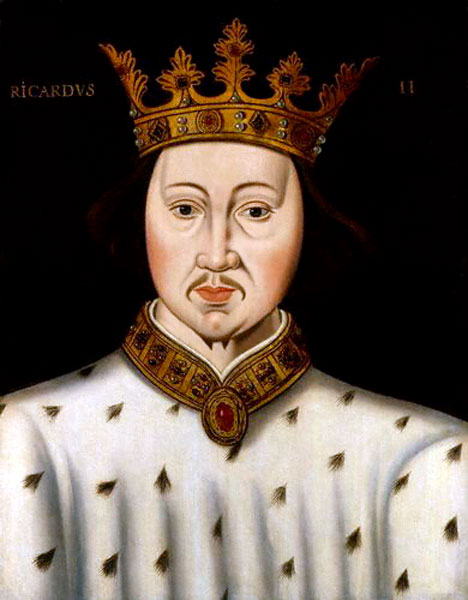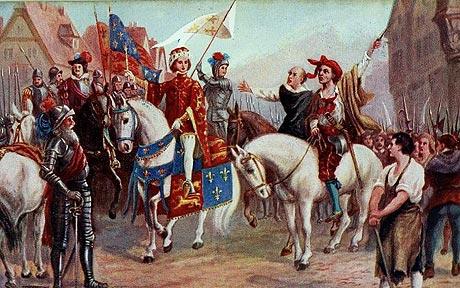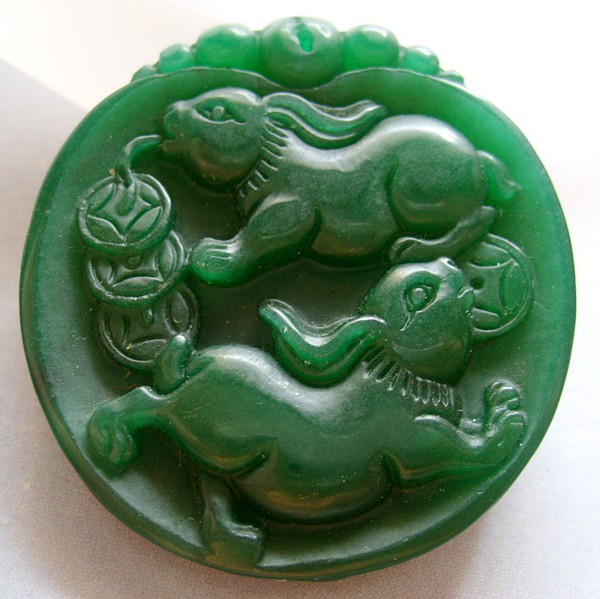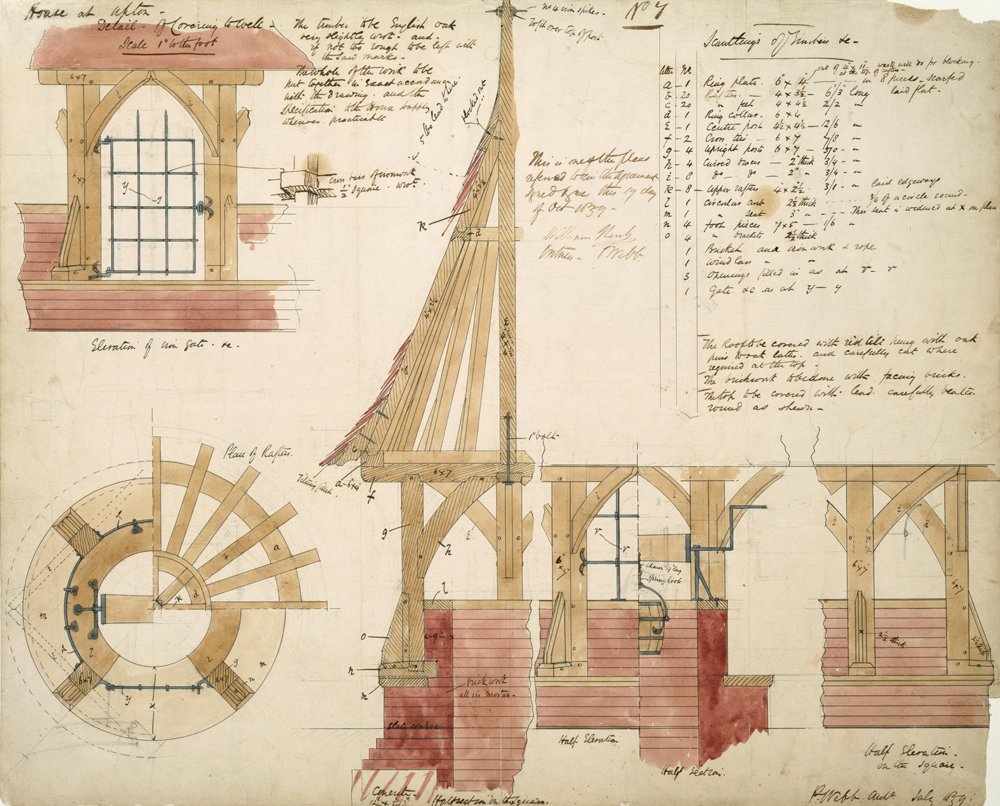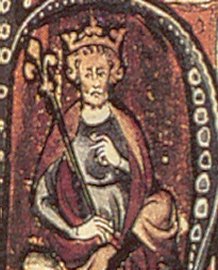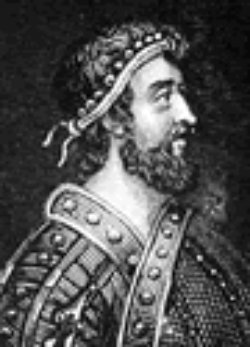Name: King Richard II
Born: January 6, 1367 at Bordeaux, France
Parents: Edward, the Black Prince, and Joan of Kent
Relation to Elizabeth II: 16th great-granduncle
House of: Plantagenet
Ascended to the throne: June 22, 1377 aged 10 years
Crowned: July 16, 1377 at Westminster Abbey
Married: (1) Anne of Bohemia, (2) Isabella, nine year old daughter of Charles VI of France
Children: None
Died: February 14, 1400 at Pontefract Castle, Yorkshire (starved to death), aged 33 years, 1 month, and 8 days
Buried at: Langley reburied Westminster
Reigned for: 22 years, 7 months, and 23 days
Succeeded by: his cousin Henry IV
King of England from 1377, effectively from 1389, son of Edward the Black Prince. He reigned in conflict with Parliament; they executed some of his associates in 1388, and he executed some of the opposing barons in 1397, whereupon he made himself absolute. Two years later, forced to abdicate in favour of Henry IV, he was jailed and died.
In 1381 Richard was faced with the Peasants’ Revolt, a result of the imposition of the Poll Tax in 1380. The leader of the Revolt, Watt Tyler, was stabbed and killed at Smithfield by the Lord Mayor of London, fearing for the safety of the king. Richard’s apparent courage in facing the mobs gathered at Mile End and Smithfield also contributed to the failure of the uprising.
Richard was born in Bordeaux. He succeeded his grandfather Edward III when only ten, the government being in the hands of a council of regency. His fondness for favourites resulted in conflicts with Parliament, and in 1388 the baronial party, headed by the Duke of Gloucester, had many of his friends executed. Richard recovered control in 1389, and ruled moderately until 1397, when he had Gloucester murdered and his other leading opponents executed or banished, and assumed absolute power. In 1399 his cousin Henry Bolingbroke, Duke of Hereford (later Henry IV), returned from exile to lead a revolt; Richard II was deposed by Parliament and imprisoned in Pontefract Castle, where he died of starvation.
Richard II (6 January 1367 – ca. 14 February 1400) was King of England from 1377 until he was deposed in 1399. Richard, a son of Edward, the Black Prince, was born during the reign of his grandfather, Edward III. Richard was the younger brother of Edward of Angoulême; upon the death of this elder brother, Richard—at four years of age—became second in line to the throne after his father. Upon the death of Richard’s father prior to the death of Edward III, Richard, by agnatic succession, became the first in line for the throne. With Edward III’s death the following year, Richard succeeded to the throne at the age of ten.
During Richard’s first years as king, government was in the hands of a series of councils. The political community preferred this to a regency led by the king’s uncle, John of Gaunt, yet Gaunt remained highly influential. The first major challenge of the reign was the Peasants’ Revolt in 1381, which the young king played a major part in suppressing. In the following years, however, the king’s dependence on a small number of courtiers caused discontent in the political community, and in 1387 control of government was taken over by a group of noblemen known as the Lords Appellant. By 1389 Richard had regained control, and for the next eight years governed in relative harmony with his former opponents. Then, in 1397, he took his revenge on the appellants, many of whom were executed or exiled. The next two years have been described by historians as Richard’s “tyranny”. In 1399, after John of Gaunt died, the king disinherited Gaunt’s son, Henry of Bolingbroke, who had previously been exiled. Henry invaded England in June 1399 with a small force that quickly grew in numbers. Claiming initially that his goal was only to reclaim his patrimony, it soon became clear that he intended to claim the throne for himself.
Meeting little resistance, Bolingbroke deposed Richard and had himself crowned as King Henry IV. Richard died in captivity early the next year; he was probably murdered.
As an individual, Richard was said to have been tall, good-looking and intelligent. Though probably not insane, as earlier historians used to believe, he may have suffered from a personality disorder towards the end of his reign. Less of a warrior than either his father or grandfather, he sought to bring an end to the Hundred Years’ War that Edward III had started. He was a firm believer in the royal prerogative, something which led him to restrain the power of his nobility, and to rely on a private retinue for military protection instead. He also cultivated a courtly atmosphere where the king was an elevated figure, and art and culture were at the centre, in contrast to the fraternal, martial court of his grandfather. Richard’s posthumous reputation has to a large extent been shaped by Shakespeare, whose play Richard II portrayed Richard’s misrule and his deposition by Bolingbroke as responsible for the fifteenth-century Wars of the Roses. Present day historians do not accept this interpretation, while not exonerating Richard from responsibility for his own deposition. Most authorities agree that, even though his policies were not unprecedented or entirely unrealistic, the way in which he carried them out was unacceptable to the political establishment, and this led to his downfall.
| Timeline for King Richard II |
| 1377 | Ten year old Richard II succeeds his grandfather, Edward III; the kingdom is ruled at first by the King’s uncles, John of Gaunt and Thomas of Gloucester. |
| 1380 | John Wycliffe begins to translate the New Testament from Latin into English . |
| 1380 | A Poll Tax is levied, a shilling a head for the entire male population |
| 1381 | Poll Tax leads to the Peasants’ Revolt. Watt Tyler and John Ball march on London. |
| 1382 | Richard promises that the taxes will be repealed, but as the rebels return they are hunted and executed. |
| 1382 | William of Wykeham founds Winchester College |
| 1387 | Led by the Duke of Gloucester, the Lords Appellant control the government |
| 1388 | Scots defeat Henry Hotspur at the Battle of Otterburn |
| 1389 | Richard takes control of the government; William of Wykeham is Lord Chancellor |
| 1394 | Richard leads English army to reconquer west of Ireland. |
| 1396 | Richard marries Isabella daughter of the King of France and signs a 28 year truce with France. |
| 1397 | Richard takes revenge against Lords Appellant and exiles Henry Bolingbroke |
| 1398 | Richard (Dick) Whittington becomes Lord Mayor of London |
| 1399 | Bolingbroke becomes Duke of Lancaster on the death of John of Gaunt, but Richard seizes his possessions. Bolingbroke returns from exile to claim his inheritance and seizes the throne. |
| 1399 | Richard, who is away fighting at Leinster in Ireland, returns, but is deposed and imprisoned in Pontefract Castle, where he dies in 1400 |
Ancestry and Early Life
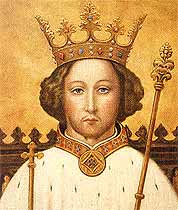 The future King Richard II was born at Bordeaux, Aquitaine, at epiphany, on 6th January, 1367. The product of a first cousin marriage, he was the son of Edward III’s eldest son, Edward, Prince of Wales, the Black Prince and his wife, Joan, Countess of Kent. Joan, known as the ‘Fair Maid of Kent’, was the daughter of Edmund, Earl of Kent, the youngest of Edward I’s sons by his second wife, Margaret of France. This gave Richard a double descent from Edward I, due to previous cousin marriages in his family, his grandparents had also been first cousins, Richard was therefore a highly inbred individual.
The future King Richard II was born at Bordeaux, Aquitaine, at epiphany, on 6th January, 1367. The product of a first cousin marriage, he was the son of Edward III’s eldest son, Edward, Prince of Wales, the Black Prince and his wife, Joan, Countess of Kent. Joan, known as the ‘Fair Maid of Kent’, was the daughter of Edmund, Earl of Kent, the youngest of Edward I’s sons by his second wife, Margaret of France. This gave Richard a double descent from Edward I, due to previous cousin marriages in his family, his grandparents had also been first cousins, Richard was therefore a highly inbred individual.
His mother, Joan of Kent, has been described as one of the most beautiful and scandalous women of her age. Unusual for the day, Richard’s parent’s marriage was a genuine love match and not a political alliance. Joan of Kent had previously been married to Thomas Holland and through this former marriage, Richard had half siblings.
Joan caused quite a scandal by entering into a clandestine marriage with Holland at the age of twelve. The following winter, while her husband was serving abroad, Joan married again to William Montacute, the Earl of Salisbury’s heir. When Holland returned to England a few years later, he revealed his secret marriage to Joan and appealed to Pope Clement VI for his wife’s return, Joan supported his appeal. Salisbury resorted to keeping her a prisoner in his home. The Pope annulled Joan’s marriage to Montacute and ordered to return to Thomas Holland, with whom she lived for the next eleven years. The marriage produced four children.
Richard had an elder brother, Edward of Angouleme, who was suspected of being mentally retarded, perhaps due to inbreeding in the Plantagenet family. Edward had died in infancy, leaving Richard his father’s sole heir.
Reign
The Black Prince predeceased Edward III, dying of a mysterious illness in June, 1376. He had obtained a promise from his father that Richard should succeed him. After his grandfather’s death, the ten year old Richard was duly crowned at Westminster Abbey on 16 July, 1377.
His charismatic grandfather and martial father were a hard act to follow. Artistic and sensitive, Richard was a pacifist, not an attitude to endear him to those of his barons who looked back to an heroic past.
Richard’s appearance
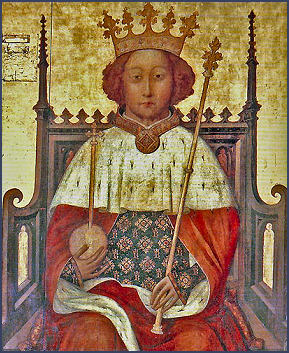 Richard is the first English monarch for whom a contemporary painting survives. He was built in the typical Plantagenet mould, around six feet tall, fair haired and good-looking, with finely chiseled features and beautiful, long, tapering hands. The chronicler Adam of Usk described him as being ‘ as beautiful as Absalom.’ Richard was also volatile and unstable, brooding and vengeful, and in him the famed Plantagenet temper boiled into a frenzy.
Richard is the first English monarch for whom a contemporary painting survives. He was built in the typical Plantagenet mould, around six feet tall, fair haired and good-looking, with finely chiseled features and beautiful, long, tapering hands. The chronicler Adam of Usk described him as being ‘ as beautiful as Absalom.’ Richard was also volatile and unstable, brooding and vengeful, and in him the famed Plantagenet temper boiled into a frenzy.
A description by a Monk of Elvetham relates:
King Richard was of the common stature, his hair yellowish, his face fair and rosy, rather round than long, and sometimes flushed; abrupt and somewhat stammering in his speech, capricious in his manners, and too apt to prefer the recommendations of the young, to the advice of the elder, nobles. He was prodigal in his gifts, extravagantly splendid in his entertainment and dress, timid as to war, very passionate toward his domestics, haughty and too much devoted to voluptuousness. So fond of late hours, that he would sometimes sit up all night drinking.
The Peasant’s Revolt
The country was governed by Richard’s uncle John of Gaunt and a council during his minority. In 1381, when Richard was fourteen, the Peasants Revolt, probably the first socialist movement in English history, broke out in Kent in reaction to a highly unpopular poll tax. The rebels marched up to London, their leaders, Watt Tyler, Jack Straw and a priest, John Ball, demanded the abolition of serfdom and a pardon for all participants in the uprising. Discontented recruits to the cause were many and their army swelled to what is estimated at around ten thousand.
All those connected with the hated poll tax were summarily executed on the peasants progress to London. John Ball chose as his text :- “When Adam delved (dug) and Eve span, who was then the gentleman?” The rebels were welcomed by the majority of Londoners and the army camped at Blackheath on 14th June, threatening London.
Watt Tyler met Richard and his terrified retinue at Mile End. The young King’s position was precarious and having little choice, he ordered charters drawn up granting all of Tyler’s requests. A further meeting was arranged at Smithfield. Tyler attended alone and repeated further demands. Richard wearily conceded to grant them all. Washing out his mouth with water, Tyler proceeded to spit it out in the king’s presence, at which Walworth, the Mayor of London, incensed at what he saw as impertinence, stabbed Tyler to death. The rebel army were unclear at what was happening in the distance, seizing the initiative, Richard advanced alone, calling out loudly “I am your King follow me.” and led the rebel army away. The revolt was put down with severity, the young king, in a characteristic outburst of venom, wreaked a terrible vengeance and the heads of it’s leaders were displayed on pikes at London Bridge.
At fifteen, Richard married Anne of Bohemia in St. Stephen’s Chapel at Westminster Abbey. Anne was the daughter of the Holy Roman Emperor, Charles IV, and the sister of King Wenceslas of Bohemia. The couple were to become devoted to each other and the queen exercised a moderating influence on her husband but their union produced no issue.
The Lords Appellant
King Richard II, like Edward II before him, was unfortunately reckless in his generosity to favorites, Robert de Vere, Earl of Oxford was raised to a Duke. Anger smouldered and came to a head in 1387 when Richard failed to bring certain of his favourites to trial, he was subjected to force. He was defeated by a rebel army led by his uncle, Thomas, Duke of Gloucester at Radcot Bridge in Oxfordshire, Gloucester had been joined by John of Gaunt’s son, Henry of Bolingbroke. At the ‘Merciless Parliament’ of 1388. The Lords Appellant demanded radical changes in the royal household, the execution of the king’s principal supporters and de Vere’s estates confiscated. The House of Commons feared the King’s attempts to undermine the authority of parliament and he was placed under the control of a council. Their intransigence fueled a smouldering desire for revenge in the unstable Richard.
Richard delighted in lavish dress and extravagant jewels. He is popularly credited with introducing the use of the pocket handkerchief. In common with his ancestor Henry III, he venerated the memory of the Saxon King, Edward the Confessor and adopted his coat of arms, which were quartered with his own.
The Death of Queen Anne
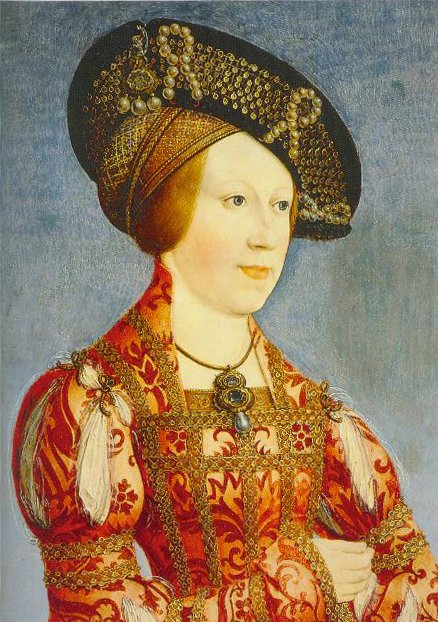 Tragically, his beloved Queen, Anne, died of the plague in 1394, aged but twenty-eight. Richard’s grief was terrible, distraught and emotionally unstabilized, he had Sheen Palace, where Anne had died, razed to the ground. The Queen was buried at Westminster near to St. Edward’s shrine. An embarrassing incident marred the funeral service, Richard was angered by Richard Fitzalan, Earl of Arundel, who had the audacity to arrive late. When he tactlessly asked the King to excuse his attendance, Richard completely lost control. In his passionate grief and fury he seized a wand from one of the vergers and struck Arundel so violently about the head with it that he fell to the ground dazed.
Tragically, his beloved Queen, Anne, died of the plague in 1394, aged but twenty-eight. Richard’s grief was terrible, distraught and emotionally unstabilized, he had Sheen Palace, where Anne had died, razed to the ground. The Queen was buried at Westminster near to St. Edward’s shrine. An embarrassing incident marred the funeral service, Richard was angered by Richard Fitzalan, Earl of Arundel, who had the audacity to arrive late. When he tactlessly asked the King to excuse his attendance, Richard completely lost control. In his passionate grief and fury he seized a wand from one of the vergers and struck Arundel so violently about the head with it that he fell to the ground dazed.
Two years later Richard married again, taking Isabelle, the seven year old daughter of Charles VI of France, as his second wife. Richard treated her with great kindness and they were to become extremely fond of each other.
Henry of Bolingbroke
Richard’s brooding on past slights culminated with his taking action with ruthless suddeness in 1397. His old opponents were placed under arrest and his uncle, Thomas of Gloucester, was murdered. He exiled his cousin, Henry Bolingbroke, who was one of the five Lords Appellant, in 1399. On John of Gaunt’s death, the following year, Richard disinherited Henry and confiscated the vast Lancastrian estates.
Henry reacted by invading England, landing at Ravenspur in Yorkshire, on the pretext of recovering his estates, but in reality he intended to seize his cousin’s throne. Richard, in Ireland at the time, sailed to Wales. The King met Henry’s representatives at Conway Castle and was informed that if he restored Henry’s estates and surrendered certain councillors for trial, he could remain in power. He agreed but was betrayed and instead of being returned to power found himself the inhabitant of a dungeon in the Tower.
The Death of Richard II
A Parliament was called at the end of September, at which Henry claimed the throne. Richard was declared a tyrant and deposed. He was taken up to Pontefract Castle, in Yorkshire and there it is certain, he met his end around the second week in February, 1400. His skeleton was examined in 1871 by Dean Stanley of Westminster but showed no marks of violence. Starvation was the most likely cause, although this has never been proven.
After being displayed at St. Paul’s, Richard’s body was buried in King’s Langley Church, Hertfordshire. His child queen, Isabelle of France, mourned him deeply and sincerely. Henry IV wished to make an alliance between herself and his eldest son, Henry, now Prince of Wales, but loyal to the memory of her husband, she was inflexible in refusing to even contemplate it. Isabelle was eventually returned to her father in France. She was married to Charles of Angouleme and tragically died in childbirth.
Richard II’s body was later moved to Westminster Abbey by Bolingbroke’s successor, Henry V, who had been close to him in his boyhood, there it was reburied beside his beloved first wife, Anne of Bohemia.
Credits
Wikipedia

